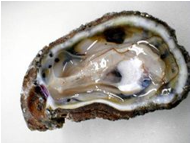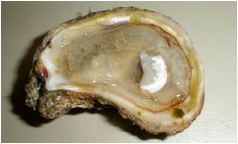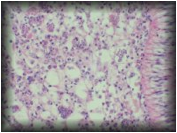Disease Monitoring
A major threat to the survival of oysters in the Chesapeake Bay is Dermo disease. Below is some general information on Dermo as well as the Paynter Lab disease monitoring program.
General Information
Dermo is caused by the single-celled protozoan parasite Perkinsus marinus. Dermo is an intracellular parasite that infects the hemocytes (blood cells) of the oyster. Dermo is not harmful to humans but can cause a range of problems in oysters, from sub-lethal infections that affect growth and fecundity to massive mortality events. Dermo infection can take up to two years to manifest in an individual and therefore juvenile oysters are not monitored for the disease. Below is a picture of an infected (left) and healthy (right) oyster.
 
Photo: http://www.livingclassrooms.org/lbo/dermo/dermoframe.html
Transmission
Dermo is most often spread through the disintegration of dead infected oysters. Uninfected oysters ingest active parasites released from dead infected oysters and become infected themselves. Dermo can be spread over long distances through live parasites in the water column. Transmission may also occur by vectors other than oysters such as scavengers feeding on dead infected oysters.
Environmental Factors
Dermo infections are most prevalent in warm, high salinity waters. The parasite proliferates in waters warmer than 25°C and salinities greater than 10‰. In the colder months of the year, Dermo can become dormant and therefore may be undetectable in oysters that are actually infected with the parasite. Due to these environmental factors, the Paynter Lab monitors oyster populations for Dermo during the fall (late August – early October).
Disease Detection
The Paynter Lab monitors for Dermo according to the practices of the Virginia Institute of Marine Science’s Shellfish Pathology Laboratory. The VIMS Shellfish Pathology Lab is a World Organization for Animal Health Reference Laboratory for perkinsosis (which includes Dermo) and is therefore the standard in Dermo monitoring. Oyster samples (gill cross-section and anal tissue) are tested for Dermo infection by incubating Ray’s Fluid thioglycollate media for 4 – 7 days. After the incubation period, samples are examined under a microscope and Dermo cells are counted by Paynter Lab staff. Dermo infection levels are scored on a scale of 0 – 5, as indicated by the table below.
Infection Intensity |
Criteria |
Weighted Prevalence Score |
Negative (N) |
No parasite cells found in the preparation. |
0 |
Rare (R) |
1-2 parasite cells found in the entire preparation. |
0.5 |
Very Light (VL) |
3-10 parasite cells found in the entire preparation. |
1 |
Light (L) |
11-100 parasite cells found in the entire preparation. |
1 |
Light to Moderate (LM) |
100+ parasite cells found in the entire preparation. |
3 |
Moderate (M) |
Parasite cells are so numerous that you expect to find them in all fields of vision under 100x power. |
3 |
Moderate to Heavy (MH) |
Parasites are present in large numbers and half of the tissue appears black and blue macroscopically. |
5 |
Heavy (H) |
Parasites are present in large numbers and nearly all of the tissue appears black and blue macroscopically. |
5 |
Very Heavy (VH) |
Parasites are present in large numbers and ALL of the tissue appears black and blue macroscopically. |
5 |
Below is a photo of oyster tissue with very heavy Dermo infection. Parasite cells appear as circular black spots in the tissue.

Photo: http://www.vims.edu/research/departments/eaah/programs/shellpath/pathology_images/index.php
For more information on Dermo, please visit the VIMS Shellfish Pathology Lab Dermo Fact Sheet.
For more information on Paynter Lab Dermo monitoring or to request specific infection data, please contact paynteroysterlab@gmail.com
|




